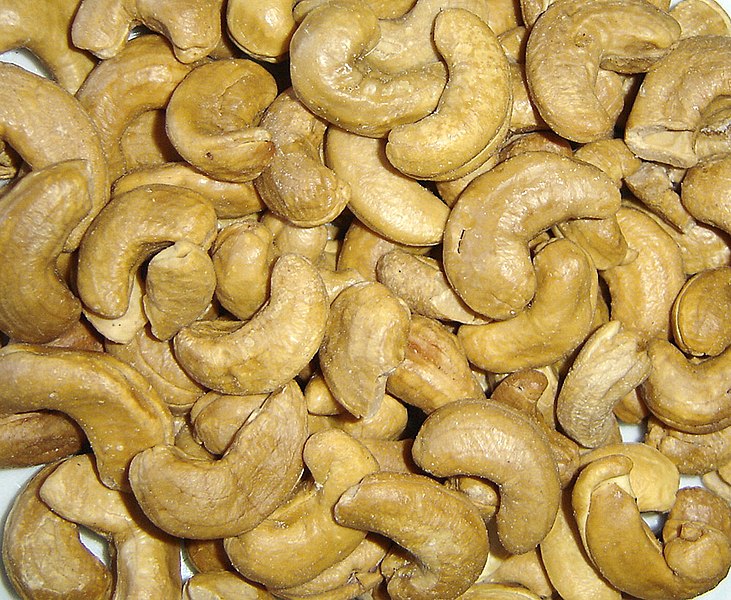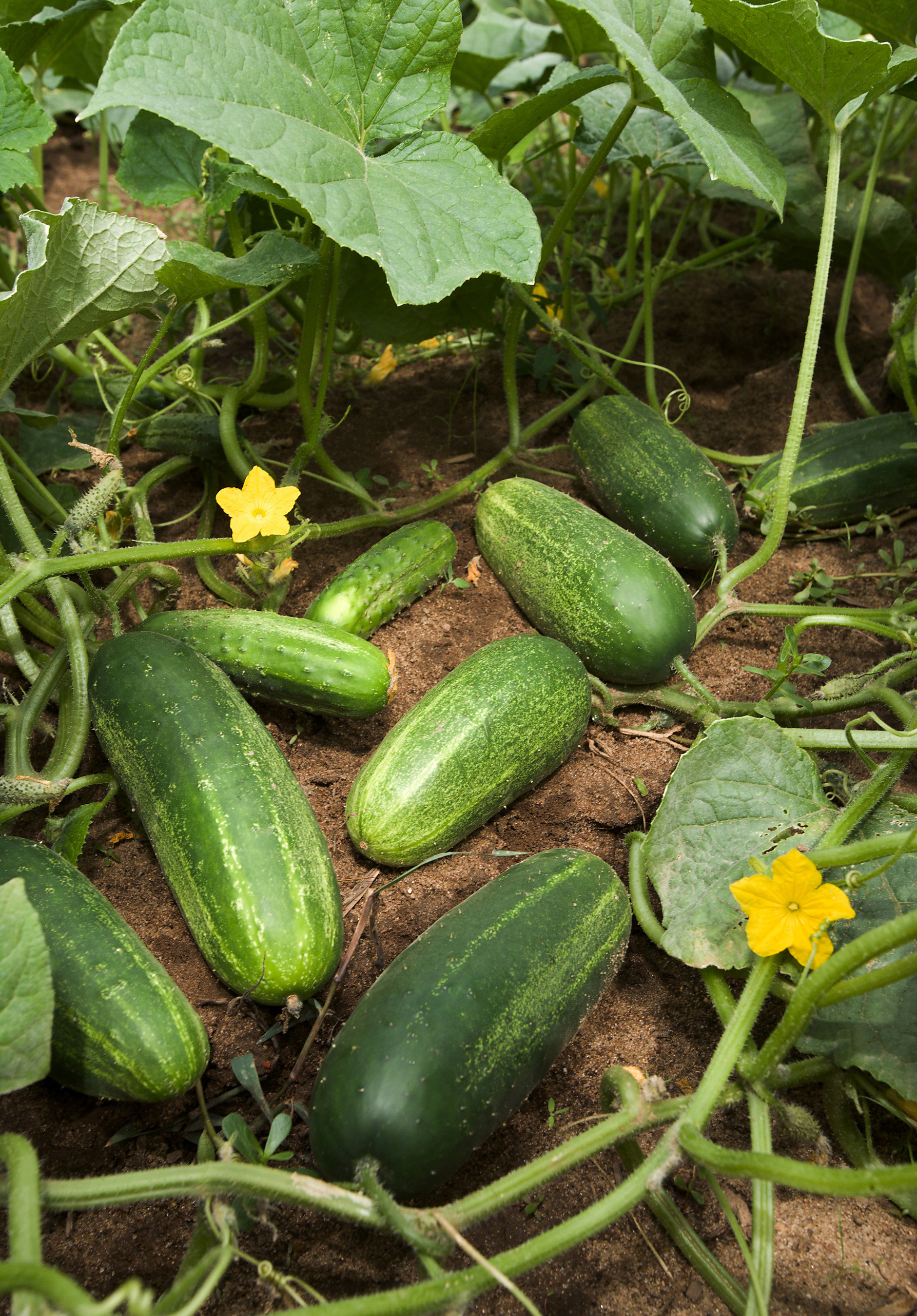Cashews vs. Cucumber
Nutrition comparison of Cashews and Cucumber
Ever wonder how your favorite foods stack up against each other in terms of nutrition?
We compared the nutritional contents of
cashews
versus
cucumber
(100g each)
below using 2020 USDA and NIH data[1].
For a quick recap of significant nutrients and differences in cashews and cucumber:
- Cashew has more thiamin, niacin, pantothenic acid, Vitamin B6 and folate.
- Cashew is an excellent source of dietary fiber, iron, potassium and protein.
- Cucumber has 72% less sugar than cashew.
USDA sources for nutritional information: Cashews (Nuts, cashew nuts, raw) and Cucumber (Cucumber, with peel, raw) . Have a correction or suggestions? Shoot us an email.
Calories and Carbs
calories
Cashew is high in calories and cucumber has 97% less calories than cashew - cucumber has 15 calories per 100 grams and cashew has 553 calories.
For macronutrient ratios, cashews is much lighter in carbs, much heavier in fat and similar to cucumber for protein. Cashews has a macronutrient ratio of 13:21:67 and for cucumber, 15:80:5 for protein, carbohydrates and fat from calories.
Macro Ratios from Calories:
| Cashews | Cucumber | |
|---|---|---|
| Protein | 13% | 15% |
| Carbohydrates | 21% | 80% |
| Fat | 67% | 5% |
| Alcohol | ~ | ~ |
carbohydrates
Cashew is high in carbohydrates and cucumber has 88% less carbohydrates than cashew - cucumber has 3.6g of total carbs per 100 grams and cashew has 30.2g of carbohydrates.
dietary fiber
Cashew is an excellent source of dietary fiber and it has 560% more dietary fiber than cucumber - cucumber has 0.5g of dietary fiber per 100 grams and cashew has 3.3g of dietary fiber.
sugar
Cucumber has 72% less sugar than cashew - cucumber has 1.7g of sugar per 100 grams and cashew has 5.9g of sugar.
Protein
protein
Cashew is an excellent source of protein and it has 27 times more protein than cucumber - cucumber has 0.65g of protein per 100 grams and cashew has 18.2g of protein.
Fat
saturated fat
Cashew is high in saturated fat and cucumber has 100% less saturated fat than cashew - cucumber has 0.04g of saturated fat per 100 grams and cashew has 7.8g of saturated fat.
Vitamins
Vitamin C
Cucumber and cashews contain similar amounts of Vitamin C - cucumber has 2.8mg of Vitamin C per 100 grams and cashew has 0.5mg of Vitamin C.
Vitamin A
Cucumber and cashews contain similar amounts of Vitamin A - cucumber has 5ug of Vitamin A per 100 grams and cashew does not contain significant amounts.
Vitamin E
Cucumber and cashews contain similar amounts of Vitamin E - cucumber has 0.03mg of Vitamin E per 100 grams and cashew has 0.9mg of Vitamin E.
Vitamin K
Cucumber and cashews contain similar amounts of Vitamin K - cucumber has 16.4ug of Vitamin K per 100 grams and cashew has 34.1ug of Vitamin K.
The B Vitamins
Cashew has more thiamin, niacin, pantothenic acid, Vitamin B6 and folate. Both cashews and cucumber contain significant amounts of riboflavin.
| Cashews | Cucumber | |
|---|---|---|
| Thiamin | 0.423 MG | 0.027 MG |
| Riboflavin | 0.058 MG | 0.033 MG |
| Niacin | 1.062 MG | 0.098 MG |
| Pantothenic acid | 0.864 MG | 0.259 MG |
| Vitamin B6 | 0.417 MG | 0.04 MG |
| Folate | 25 UG | 7 UG |
Minerals
calcium
Cashew has 131% more calcium than cucumber - cucumber has 16mg of calcium per 100 grams and cashew has 37mg of calcium.
iron
Cashew is an excellent source of iron and it has 22 times more iron than cucumber - cucumber has 0.28mg of iron per 100 grams and cashew has 6.7mg of iron.
potassium
Cashew is an excellent source of potassium and it has 349% more potassium than cucumber - cucumber has 147mg of potassium per 100 grams and cashew has 660mg of potassium.
Antioxidants and Phytonutrients
carotenoids
Carotenoids are micronutrients commonly found in plants and some animal products. An example is beta-carotene, the notable carotenoid which is a popular source of Vitamin A.[4][5]
For specific types of carotenoids, both cashews and cucumber contain significant amounts of lutein + zeaxanthin.
| Cashews | Cucumber | |
|---|---|---|
| lutein + zeaxanthin | 22 UG | 23 UG |
| beta-carotene | ~ | 45 UG |
| alpha-carotene | ~ | 11 UG |
Omega-3 and Omega-6
omega 3s
For omega-3 fatty acids, cashew has more alpha linoleic acid (ALA) than cucumber per 100 grams.
| Cashews | Cucumber | |
|---|---|---|
| alpha linoleic acid | 0.062 G | 0.005 G |
| Total | 0.062 G | 0.005 G |
omega 6s
Comparing omega-6 fatty acids, cashew has more linoleic acid than cucumber per 100 grams.
| Cashews | Cucumber | |
|---|---|---|
| other omega 6 | 0.266 G | ~ |
| linoleic acid | 7.782 G | 0.028 G |
| Total | 8.048 G | 0.028 G |
Customize your serving size
The comparison below is by common portions, e.g. cups, packages. You can also see a more concrete comparison by weight at equal weight (by grams) comparison.
Cashews g
()
|
Daily Values (%) |
Cucumber g
()
|
|||||
|---|---|---|---|---|---|---|---|
| KCAL % |
|
5% | calories | 5% |
|
KCAL % | |
| G % |
|
5% | carbohydrates | 5% |
|
G % | |
| G % |
|
5% | dietary fiber | 5% |
|
G % | |
| G | 5% | sugar | 5% | G | |||
| G % |
|
5% | total fat | 5% |
|
G % | |
| G % |
|
5% | saturated fat | 5% |
|
G % | |
| G | 5% | monounsaturated fat | 5% | G | |||
| G | 5% | polyunsaturated fat | 5% | G | |||
| G | 5% | trans fat | 5% | G | |||
| MG | 5% | cholesterol | 5% | MG | |||
| MG % |
|
5% | sodium | 5% |
|
MG % | |
| 5% | Vitamins and Minerals | 5% | |||||
| UG % |
|
5% | Vitamin A | 5% |
|
UG % | |
| MG % |
|
5% | Vitamin C | 5% |
|
MG % | |
| IU % |
|
5% | Vitamin D | 5% |
|
IU % | |
| MG % |
|
5% | calcium | 5% |
|
MG % | |
| MG % |
|
5% | iron | 5% |
|
MG % | |
| MG % |
|
5% | magnesium | 5% |
|
MG % | |
| MG % |
|
5% | potassium | 5% |
|
MG % | |
| MG % |
|
5% | thiamin (Vit B1) | 5% |
|
MG % | |
| MG % |
|
5% | riboflavin (Vit B2) | 5% |
|
MG % | |
| MG % |
|
5% | niacin (Vit B3) | 5% |
|
MG % | |
| MG % |
|
5% | Vitamin B6 | 5% |
|
MG % | |
| MG % |
|
5% | pantothenic acid (Vit B5) | 5% |
|
MG % | |
| UG % |
|
5% | folate (Vit B9) | 5% |
|
UG % | |
| UG % |
|
5% | Vitamin B12 | 5% |
|
UG % | |
| MG % |
|
5% | Vitamin E | 5% |
|
MG % | |
| UG % |
|
5% | Vitamin K | 5% |
|
UG % | |
| G % |
|
5% | protein | 5% |
|
G % | |
| UG % |
|
5% | biotin (Vit B7) | 5% |
|
UG % | |
| MG % |
|
5% | choline | 5% |
|
MG % | |
| MG % |
|
5% | chlorine | 5% |
|
MG % | |
| UG % |
|
5% | chromium | 5% |
|
UG % | |
| MG % |
|
5% | copper | 5% |
|
MG % | |
| UG % |
|
5% | fluoride | 5% |
|
UG % | |
| UG % |
|
5% | iodine | 5% |
|
UG % | |
| MG % |
|
5% | manganese | 5% |
|
MG % | |
| UG % |
|
5% | molybdenum | 5% |
|
UG % | |
| MG % |
|
5% | phosphorus | 5% |
|
MG % | |
| UG % |
|
5% | selenium | 5% |
|
UG % | |
| MG % |
|
5% | zinc | 5% |
|
MG % | |
| G | 5% | Water | 5% | G | |||
| G | 5% | Starch | 5% | G | |||
| G | 5% | Alcohol | 5% | G | |||
FAQ
Does cucumber or cashews contain more calories in 100 grams?Cashew is high in calories and cucumber has 100% less calories than cashew - cucumber has 15 calories in 100g and cashew has 553 calories.
Does cucumber or cashews have more carbohydrates?
By weight, cashew is high in carbohydrates and cucumber has 90% fewer carbohydrates than cashew - cucumber has 3.6g of carbs for 100g and cashew has 30.2g of carbohydrates.
Does cucumber or cashews contain more iron?
Cashew is an abundant source of iron and it has 22 times more iron than cucumber - cucumber has 0.28mg of iron in 100 grams and cashew has 6.7mg of iron.
Does cucumber or cashews contain more potassium?
Cashew is a rich source of potassium and it has 350% more potassium than cucumber - cucumber has 147mg of potassium in 100 grams and cashew has 660mg of potassium.

